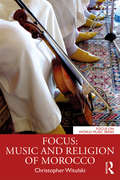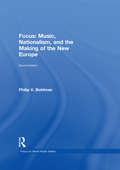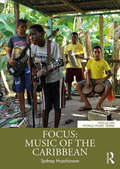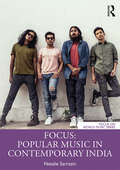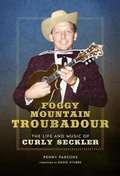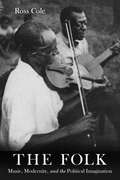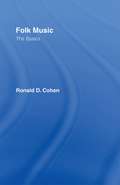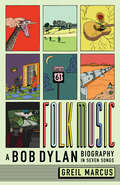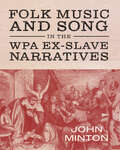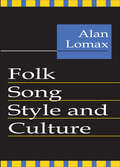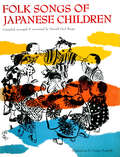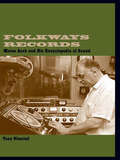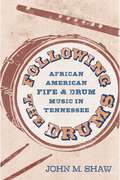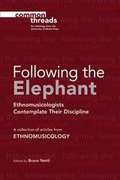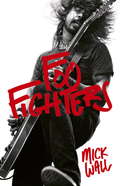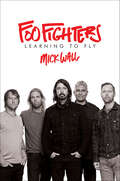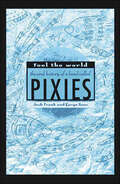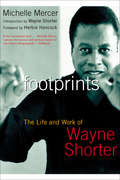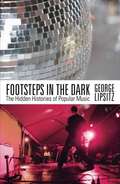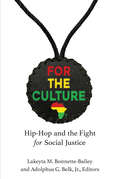- Table View
- List View
Focus: Music and Religion of Morocco (Focus on World Music Series)
by Christopher WitulskiFocus: Music and Religion of Morocco introduces the region and its history, highlighting how the pressures of religious life, post-colonial economic struggle, and global media come together within Moroccan musical life. Musical practices contextualize and clarify global historical and contemporary movements—many of which remain poorly understood—while articulating the daily realities of the region’s populations in ways that rarely show through current news accounts of religious extremism, poverty and inequality, and forced migration. As with other volumes in the series, Focus: Music and Religion of Morocco addresses large, conceptual issues though interwoven case studies, in three parts: Part I – Memories and Medias: Who We Are highlights how issues of religion, colonialism, nationalism, and globalization transcend boundaries through music to create a sense of personal and national identity, whether hundreds of years ago or on today's satellite television stations. Part II – Contesting Mainstreams: Where We're Going explores Morocco’s sacred and secular music practices as they relate to the country's diversity and its contemporary politics. Part III – Focusing In: Faith and Fun in Fez highlights Fez’s sacred music industry by introducing musicians who navigate musical and religious expectations to appeal to both their own devotional ethics and their audiences’ wants. Links to music examples referenced in the text can be accessed on the eResource site www.routledge.com/9781138094581
Focus: Music, Nationalism, and the Making of the New Europe (Focus on World Music Series)
by Philip V. BohlmanTwo decades after the fall of communism in Eastern Europe and one decade into the twenty-first century, European music remains one of the most powerful forces for shaping nationalism. Using intensive fieldwork throughout Europe -- from participation in alpine foot pilgrimages to studies of the grandest music spectacle anywhere in the world, the Eurovision Song Contest -- Philip V. Bohlman reveals the ways in which music and nationalism intersect in the shaping of the New Europe. Focus: Music, Nationalism, and the Making of the New Europe begins with the emergence of the European nation-state in the Middle Ages and extends across long periods during which Europe’s nations used music to compete for land and language, and to expand the colonial reach of Europe to the entire world. Bohlman contrasts the "national" and the "nationalist" in music, examining the ways in which their impact on society can be positive and negative -- beneficial for European cultural policy and dangerous in times when many European borders are more fragile than ever. The New Europe of the twenty-first century is more varied, more complex, and more politically volatile than ever, and its music resonates fully with these transformations.
Focus: Music of the Caribbean (Focus on World Music Series)
by Sydney HutchinsonFocus: Music of the Caribbean presents the most important issues of Caribbean musical history and current practice, discussing thought-provoking questions in a student-friendly fashion. It uses current ethnomusicological research on Caribbean music to tell the stories of Caribbean history—those of colonialism and neocolonialism, race and nationalism, marginalization and globalization—and to explore that history’s continuing impact on the lives, cultures, musics, and dance of modern-day people in the Caribbean and beyond. In three parts, the text presents an embodied understanding of the sounds, rhythms, and movements that exemplify the history, culture, and politics of Caribbean music: I. Caribbean Music and Caribbean History establishes a framework for thinking about Caribbean musical history and the roles race and migration play II. Music and Dance in Caribbean Societies considers how contrasting forms of dance music reconcile competing ideas about Caribbean identities past and present III. Focusing In: The Social Lives of Musical Instruments in Merengue Típico explores the music of the Dominican Cibao region through a focus of the genre’s dominant musical instruments Accessible to all students regardless of musical background, Focus: Music of the Caribbean is bolstered by web resources, including more than sixty detailed listening guides and accompanying playlists, vocabulary lists, and student quizzes. Discussion questions and activities for each chapter are featured in the text.
Focus: Popular Music in Contemporary India (Focus on World Music Series)
by Natalie SarrazinFocus: Popular Music in Contemporary India examines India’s musical soundscape beyond the classical and folk traditions of old to consider the culturally, socially, and politically rich contemporary music that is defining and energizing an Indian youth culture on the precipice of a major identity shift. From Bollywood film songs and Indo-jazz to bhangra hip-hop and Indian death metal, the book situates Indian popular music within critical and historical frameworks, highlighting the unprecedented changes the region’s music has undergone in recent decades. This critical approach provides readers with a foundation for understanding an Indian musical culture that is as diverse and complex as the region itself. Included are case studies featuring song notations, first-person narratives, and interviews of well-known artists and emerging musicians alike. Illuminated are issues of great import in India today—as reflected through its music—addressing questions of a "national" aesthetic, the effects of Western music, and identity politics as they relate to class, caste, LGBTQ perspectives, and other marginalized voices. Presented through a global lens, Focus: Popular Music in Contemporary India contextualizes the dynamic popular music of India and its vast cultural impact.
Foggy Mountain Troubadour: The Life and Music of Curly Seckler (Music in American Life)
by Penny ParsonsWith his trademark mandolin style and unequaled tenor harmonies, Curly Seckler has carved out a seventy-seven-year career in bluegrass and country music. His foundational work in Flatt and Scruggs's Foggy Mountain Boys secured him a place in bluegrass history, while his role in The Nashville Grass made him an essential part of the music's triumphant 1970s revival. Written in close collaboration with Mr. Seckler and those who know him, Foggy Mountain Troubadour is the first full-length biography of an American original. Penny Parsons follows a journey from North Carolina schoolhouses to the Grand Ole Opry stage and the Bluegrass Hall of Fame, from boarding houses to radio studios and traveling five to a car on two-lane roads to make the next show. Throughout, she captures the warm humor, hard choices, and vivid details of a brilliant artist's life as he crisscrosses a nation and a century making music.
The Folk: Music, Modernity, and the Political Imagination
by Ross ColeWho are "the folk" in folk music? This book traces the musical culture of these elusive figures in Britain and the US during a crucial period of industrialization from 1870 to 1930, and beyond to the contemporary alt-right. Drawing on a broad, interdisciplinary range of scholarship, The Folk examines the political dimensions of a recurrent longing for folk culture and how it was called upon for radical and reactionary ends at the apex of empire. It follows an insistent set of disputes surrounding the practice of collecting, ideas of racial belonging, nationality, the poetics of nostalgia, and the pre-history of European fascism. Deeply researched and beautifully written, Ross Cole provides us with a biography of a people who exist only as a symptom of the modern imagination, and the archaeology of a landscape directing flows of global populism to this day.
Folk Music: The Basics (The Basics)
by Ronald CohenFolk Music: The Basics gives a brief introduction to British and American folk music. Drawing upon the most recent and relevant scholarship, it will focus on comparing and contrasting the historical nature of the three aspects of understanding folk music: traditional, local performers; professional collectors; and the advent of professional performers in the twentieth century during the so-called "folk revival." The two sides of the folk tradition will be examined--both as popular and commercial expressions. Folk Music: The Basics serves as an excellent introduction to the players, the music, and the styles that make folk music an enduring and well-loved musical style. Throughout, sidebars offer studies of key folk performers, record labels, and related issues to place the general discussion in context.
Folk Music: A Bob Dylan Biography in Seven Songs
by Greil MarcusAcclaimed cultural critic Greil Marcus tells the story of Bob Dylan through the lens of seven penetrating songs &“Marcus delivers yet another essential work of music journalism.&”—Kirkus Reviews (starred review) &“Just as Dylan allows a song to carry him away, readers will be transported by the sheer poetry of Marcus&’ prose.&”—June Sawyers, Booklist (starred review) &“Further elevates Marcus to what he has always been: a supreme artist-critic.&”—Hilton Als Across seven decades, Bob Dylan has been the first singer of American song. As a writer and performer, he has rewritten the national songbook in a way that comes from his own vision and yet can feel as if it belongs to anyone who might listen. In Folk Music, Greil Marcus tells Dylan&’s story through seven of his most transformative songs. Marcus&’s point of departure is Dylan&’s ability to &“see myself in others.&” Like Dylan&’s songs, this book is a work of implicit patriotism and creative skepticism. It illuminates Dylan&’s continuing presence and relevance through his empathy—his imaginative identification with other people. This is not only a deeply felt telling of the life and times of Bob Dylan but a rich history of American folk songs and the new life they were given as Dylan sat down to write his own.
Folk Music and Song in the WPA Ex-Slave Narratives (American Made Music Series)
by John MintonBetween 1937 and 1940 fieldworkers in the Works Progress Administration’s Federal Writers’ Project interviewed around 3,500 formerly enslaved people in North America, resulting in roughly 20,000 pages of still unedited and inadequately indexed typescript. These accounts—the WPA ex-slave narratives—are the most substantial collection by far of folklore and oral history gathered directly from enslaved people in America. It is arguably the single greatest body of African American folklore extant, and a significant portion is devoted to folk music and song. This book considers this treasure trove in all its relevant social, cultural, and historical contexts. Nineteenth-century Black folk music developed against the backdrop of North American slavery, the American Civil War, Emancipation, the Federal occupation of the South, and a successful white supremacist paramilitary and political insurgency that led to Federal withdrawal, officially sanctioned racial terror, and Southern apartheid. The WPA ex-slave narratives describe that history in remarkable detail. Despite their inestimable value, most of the ex-slave narratives remained unpublished until the late 1970s, being almost unknown except to folklorists. Even after publication, the collection’s sheer size was a barrier. Quoting extensively from the narratives and exhaustively annotated and indexed, this volume provides readers with detailed explanations and full references for every musical item or tradition featured in the ex-slave narratives. John Minton covers instrumental music and social dancing, spirituals and hymns, singing games and lullabies, ring plays and reels, worksongs, minstrel songs, ballads, war songs, slavery laments, and much, much more. Written for both specialists and general readers, with 134 illustrations, the book also offers a general overview of the ex-slave narratives, their contents, creation, and relation to the field of African American folklore as a whole.
Folk Song Style and Culture
by Alan LomaxSong and dance style--viewed as nonverbal communications about culture--are here related to social structure and cultural history. Patterns of performance, theme, text and movement are analyzed in large samples of films an recordings from the whole range of human culture, according to the methods explained in this volume. Cantometrics, which means song as a measure of man, finds that traditions of singing trace the main historic distributions of human culture and that specific traits of performance are communications about identifiable aspects of society. The predictable and universal relations between expressive communication and social organization, here established for the first time, open up the possibility of a scientific aesthetics, useful to planners.
Folk Songs Hawaii Sings
by John M. KellyFolk Songs Hawaii Sings is a sparkling compilation of melodies from the islands of Polynesia together with a variety of folk songs that countless Oriental people have brought with them to their new home in the Hawaiian Islands. In one sense it is a musical picture of the renowned harmonious blend of people who reside in Hawaii today; in another, it is a colorful record of ties with the Eastern world and ancestral heritage in line with the same American tradition that saw songs of the soil and the sea brought to the United States from Europe in an earlier age.All the songs and more, whether from Hawaii or Samoa, China or Japan, the Philippines, Okinawa, or Mongolia, are melodic bearers of traditions and aspirations, or vehicles of simple pleasures that form the background of the people who today share the hospitable sun of the Hawaiian Islands with their Caucasian neighbors. These melodies and rhythms have found their way into the many festivals and musical presentations that are so much a way of life in the welcome addition to the American Union.
Folk Songs Hawaii Sings
by John M. KellyFolk Songs Hawaii Sings is a sparkling compilation of melodies from the islands of Polynesia together with a variety of folk songs that countless Asian people have brought with them to their new home in the Hawaiian Islands.In one sense it is a musical picture of the renowned harmonious blend of people who reside in Hawaii today; in another, it is a colorful record of ties with the Eastern world and ancestral heritage in line with the same American tradition that saw songs of the soil and the sea brought to the United States from Europe in an earlier age.All the songs and more, whether from Hawaii or Samoa, China or Japan, the Philippines, Okinawa, or Mongolia, are melodic bearers of traditions and aspirations, or vehicles of simple pleasures that form the background of the people who today share the hospitable sun of the Hawaiian Islands with their Caucasian neighbors. These melodies and rhythms have found their way into the many festivals and musical presentations that are so much a way of life in the welcome addition to the American Union.
Folk Songs of Japanese Children
by Donald Paul Berger Yoshie NoguchiThis is a delightful collection of Japanese children's songs with lyrics, sheet music and cultural notes.Simple, singable, and engaging, the traditional songs of Japanese children combine the unique charm of Japan with the universal appeal of children's music everywhere. Some of the fifteen songs in this collection are current throughout Japan. Others are little known outside a small area. All have deep roots in history and tradition. Several are game songs that will be enjoyed by all children who have played "London Bridge is Falling Down" or "The Farmer in the Dell."Mr. Berger's commentary on each song illuminates many facets of Japanese culture; and his arrangements, with easy piano accompaniments, make the songs suitable for unison or two-part singing by children or adults. The complete Japanese text, in both Japanese characters and Roman alphabet, is included for each song, together with a singable English version and a literal translation.
Folk Songs of Japanese Children
by Yoshie Noguchi Donald Paul BergerSimple, singable, and engaging, the traditional songs of Japanese children combine the unique charm of Japan with the universal appeal of children's music everywhere. Some of the fifteen songs in this collection are current throughout Japan. Others are little known outside a small area. All have deep roots in history and tradition. Several are game songs that will be enjoyed by all children who have played "London Bridge is Falling Down" or "The Farmer in the Dell." Mr. Berger's commentary on each song illuminates many facets of Japanese culture; and his arrangements, with easy piano accompaniments, make the songs suitable for unison or two-part singing by children or adults. The complete Japanese text, in both Japanese characters and Roman alphabet, is included for each song, together with a singable English version and a literal translation.
Folkways Records: Moses Asch and His Encyclopedia of Sound
by Tony OlmstedIn 1949, immigrant recording engineer Moses Asch embarked on a lifelong project: documenting the world of sound produced by mankind, via a small record label called Folkways Records. By the time of his death in 1986, he had amassed an archive of over 2,200 LPs and thousands of hours of tapes; so valuable was this collection that it was purchased by the Smithsonian Institute. Folkways Records is an account of how he built this business, working against all odds, to create a landmark in the history of American music.
Follow Your Heart: Moving with the Giants of Jazz, Swing, and Rhythm and Blues
by Christopher Brooks Joe EvansDetailing the fascinating career of Joe Evans, Follow Your Heart chronicles the nearly thirty years that he spent immersed in one of the most exciting times in African American music history. An alto saxophonist who between 1939 and 1965 performed with some of America's greatest musicians, including Louis Armstrong, Cab Calloway, Charlie Parker, Jay McShann, Andy Kirk, Billie Holiday, Bill "Bojangles" Robinson, Lionel Hampton, and Ivory Joe Hunter, Evans warmly recounts his wide range of experience in the music industry. Readers follow Evans from Pensacola, Florida, where he first learned to play, to such exotic destinations as Tel Aviv and Paris, which he visited while on tour with Lionel Hampton. Evans also comments on popular New York City venues used for shaping and producing black music, such as the Apollo Theater, the Savoy, Minton's Playhouse, and the Rhythm Club. Revealing Evans as a master storyteller, Follow Your Heart describes his stints as a music executive, entrepreneur, and musician. Evans provides rich descriptions of jazz, swing, and rhythm and blues culture by highlighting his experiences promoting tracks to radio deejays under Ray Charles's Tangerine label and later writing, arranging, and producing hits for the Manhattans and the Pretenders. Leading numerous musical ventures that included a publishing company and several labels--Cee Jay Records (with Jack Rags), Revival, and Carnival Records--Evans remained active in the music industry even after he stopped performing regularly. As one of the few who enjoyed success as both performer and entrepreneur, he offers invaluable insight into race relations within the industry, the development of African American music and society from the 1920s to 1970s, and the music scene of the era.
Following the Drums: African American Fife and Drum Music in Tennessee (American Made Music Series)
by John M. ShawFollowing the Drums: African American Fife and Drum Music in Tennessee is an epic history of a little-known African American instrumental music form. John M. Shaw follows the music from its roots in West Africa and early American militia drumming to its prominence in African American communities during the time of Reconstruction, both as a rallying tool for political militancy and a community music for funerals, picnics, parades, and dances. Carefully documenting the music's early uses for commercial advertising and sports promotion, Shaw follows the strands of the music through the nadir of African American history during post-Reconstruction up to the form's rediscovery by musicologists and music researchers during the blues and folk revival of the late 1960s and early 1970s. Although these researchers documented the music, and there were a handful of public performances of the music at festivals, the story has a sad conclusion. Fife and drum music ultimately died out in Tennessee during the early 1980s.Newspaper articles from the period and interviews with music researchers and participants reawaken this lost expression, and specific band leaders receive the spotlight they so long deserved. Following the Drums is a journey through African American history and Tennessee history, with a fascinating form of music powering the story.
Following the Elephant: Ethnomusicologists Contemplate Their Discipline
by Bruno NettlIn Following the Elephant, Bruno Nettl edits articles drawn from fifty years of the pioneering journal Ethnomusicology. The roster of acclaimed scholars hail from across generations, using other works in the collection as launching points for dialogues on the history and accomplishments of the field. Nettl divides the collection into three sections. In the first, authors survey ethnomusicology from perspectives that include thoughts on defining and conceptualizing the field and its concepts. The second section offers milestones in the literature that critique major works. The authors look at what separates ethnomusicology from other forms of music research and discuss foundational issues. The final section presents scholars considering ethnomusicology--including recent trends--from the perspective of specific, but abiding, strands of thought. Contributors: Charlotte J. Frisbie, Mieczylaw Kolinski, Gerhard Kubik, George List, Alan P. Merriam, Bruno Nettl, David Pruett, Adelaida Reyes, Timothy Rice, Jesse D. Ruskin, Kay Kaufman Shelemay, Gabriel Solis, Jeff Todd Titon, J. Lawrence Witzleben, and Deborah Wong
Foo Fighters
by Mick WallEveryone from Sir Paul McCartney and Jimmy Page to Queens of the Stone Age now relishes the chance to share a stage with Dave Grohl and his legendary Foo Fighters. The question is: why? Musical depth? Not really. Major success? Well, yes. Despite no longer shifting albums in the same quantity as they did twenty years ago, this band can still fill stadiums the world over (when Dave's not breaking his leg, of course).Long before Kurt Cobain blew his brains out in 1994, Dave Grohl was planning for a life after Nirvana. The unflinching bright sunlight to Cobain's permanent midnight darkness, Grohl had come from a similar broken home to his erstwhile band leader, but came out of the experience differently - brimming with positivity and a shrewd grasp of opportunities in the music industry.Did Grohl merely take the sonic blueprint of Nirvana and embellish it with a more life-affirming pop sheen? Of course he did. Every band in America that sold over a million records in the post-grunge 90s did the same. The difference was that Grohl had real credibility. And he knew it.With exclusive testimony from true insiders (including Krist Novoselic, Grohl's bass-playing partner in Nirvana, ex-girlfirends, record company executives, tour photographers and confidantes), this book is an exploration of the real story behind Grohl and the Foo Fighters - the only serious literary biography of the group and its leader, one of the most famous and critically bulletproof rock figures of the 21st century.
Foo Fighters: Learning to Fly
by Mick WallThere’s a reason why Dave Grohl is known, however naively, as “the nicest man in rock.” A reason why millions have bought his Foo Fighters albums and DVDs, his concert and festival tickets. A reason why generations have bought into his story, his dream, his self-fulfilling prophecies. Dave may not have the savant glamour of Nirvana’s Kurt Cobain, but whereas Kurt dwelled in darkness, Dave was a lover, not a loner, a bringer of light.Foo Fighters: Learning to Fly is his story, and therefore the true story of the Foo Fighters—like it’s never been told before. From Grohl’s days as the new kid in Nirvana, to becoming the Grunge Ringo of the Foo Fighters, to where he is now: one of the biggest, most popular male rock stars in the world. Internationally acclaimed rock writer Mick Wall tells us how and why none of this happened by accident in a style that pulses with rock’s own rhythms.With testimony from true insiders, including former band mates, like Nirvana bass player Krist Novoselic, producers, record company executives, and those closest to Grohl and the Foos, this is the first full, explosive, no-holds-barred biography of the band and their otherwise critically bulletproof leader.
Fool the World: The Oral History of a Band Called Pixies
by Josh Frank Caryn GanzIt's the 1980s and the rock landscape is littered with massive hair, synthesizers, and monster riffs, but there is an alternative being born in the sleepy East of America-we just don't know it yet.Before the Internet, MTV, and iPods provided far-off music fans with information and communities-and before Nirvana-kids across the world grew up in relative isolation, dependent on mix tapes and self-created art to slowly spread scenes and trends. It was under these conditions that four young musicians found one another in Boston, Massachusetts, and started a band called Pixies.During their initial seven-year career, Pixies would play some of Europe's most gigantic festivals, keep the press guessing, and cultivate a fervid international fan base hungry for more and more of their unique surf punk. The band worked fast, cranking out four albums at a breakneck pace, but ultimately pressures and personality clashes took their toll: Pixies broke up just as bands were singing their praises as the rock'n'roll innovators. For twelve years, a Pixies reunion seemed impossible, but a sudden announcement in 2004 proclaimed the unthinkable-Pixies were getting back together. Their extremely successful reunion tour finally gave the group something they'd always lacked in their homeland: proof that their bone-rattling music had left an indelible impact. Fool the World tells Pixies' story in the words of those who lived it, from the band members to studio owners, from A&R executives, producers, and visual artists who worked with them to admirers of their music, such as Bono, PJ Harvey, Beck, and Perry Farrell. With new cartoons by Trompe Le Monde illustrator Steven Appleby, Fool the World is a complete journey through the life, death, and rebirth of one of the most influential bands of all time.
Footprints
by Michelle MercerSaxophonist and composer Wayne Shorter has not only left his footprints on our musical terrain, he has created a body of work that is a monument to artistic imagination. Throughout Shorter's extraordinary fifty-year career, his compositions have helped define the sounds of each distinct era in the history of jazz. Filled with musical analysis by Mercer, enlivened by Shorter's vivid recollections, and enriched by more than seventy-five original interviews with his friends and associates, this book is at once an invaluable history of music from bebop to pop, an intimate and moving biography, and a story of a man's struggle toward the full realization of his gifts and of himself. .
Footsteps in the Dark: The Hidden Histories of Popular Music
by George LipsitzMost pop songs are short-lived. They appear suddenly and, if they catch on, seem to be everywhere at once before disappearing again into obscurity. Yet some songs resonate more deeply—often in ways that reflect broader historical and cultural changes. <p><p> In Footsteps in the Dark, George Lipsitz illuminates these secret meanings, offering imaginative interpretations of a wide range of popular music genres from jazz to salsa to rock. Sweeping changes that only remotely register in official narratives, Lipsitz argues, can appear in vivid relief within popular music, especially when these changes occur outside mainstream white culture. Using a wealth of revealing examples, he discusses such topics as the emergence of an African American techno music subculture in Detroit as a contradictory case of digital capitalism and the prominence of banda, merengue, and salsa music in the 1990s as an expression of changing Mexican, Dominican, and Puerto Rican nationalisms. Approaching race and popular music from another direction, he analyzes the Ken Burns PBS series Jazz as a largely uncritical celebration of American nationalism that obscures the civil rights era’s challenge to racial inequality, and he takes on the infamous campaigns to censor hip-hop and the radical black voice in the early 1990s. <p><p> Teeming with astute observations and brilliant insights about race and racism, deindustrialization, and urban renewal and their connections to music, Footsteps in the Dark puts forth an alternate history of post–cold war America and shows why in an era given to easy answers and clichéd versions of history, pop songs matter more than ever. <p><p> George Lipsitz is professor of black studies and sociology at the University of California, Santa Barbara. Among his many books are Life in the Struggle, Dangerous Crossroads, and American Studies in a Moment of Danger (Minnesota, 2001).
For Freedom: The Story of a French Spy
by Kimberly Brubaker BradleyA teenager transforms from a schoolgirl to a spy in this true story of heroism in wartime. Suzanne David's everyday life is suddenly shattered in 1940 when a bomb drops on the main square of her hometown, the city of Cherbourg, France, killing a pregnant neighbor right in front of her. Until then the war had seemed far away, not something that would touch her or her teenage friends. Now Suzanne's family is kicked out onto the street as German soldiers take over their house as a barracks. Suzanne clings to the one thing she really loves--singing. Her voice is so amazing that she is training to become an opera singer. As Suzanne travels around for rehearsals, costume fittings, or lessons, she learns more about what the Nazis are doing and about the people who are "disappearing." Her travels are noticed by someone else, an organizer of the French Resistance. Soon Suzanne is a secret courier, a spy fighting for France and risking her own life for freedom.
For the Culture: Hip-Hop and the Fight for Social Justice (Music and Social Justice)
by Lakeyta Bonnette-Bailey Adolphus BelkFor the Culture: Hip-Hop and the Fight for Social Justice documents and analyzes the ways in which Hip-Hop music, artists, scholars, and activists have discussed, promoted, and supported social justice challenges worldwide. Drawing from diverse approaches and methods, the contributors in this volume demonstrate that rap music can positively influence political behavior and fight to change social injustices, and then zoom in on artists whose work has accomplished these ends. The volume explores topics including education and pedagogy; the Black Lives Matter movement; the politics of crime, punishment, and mass incarceration; electoral politics; gender and sexuality; and the global struggle for social justice. Ultimately, the book argues that Hip-Hop is much more than a musical genre or cultural form: Hip-Hop is a resistance mechanism.
